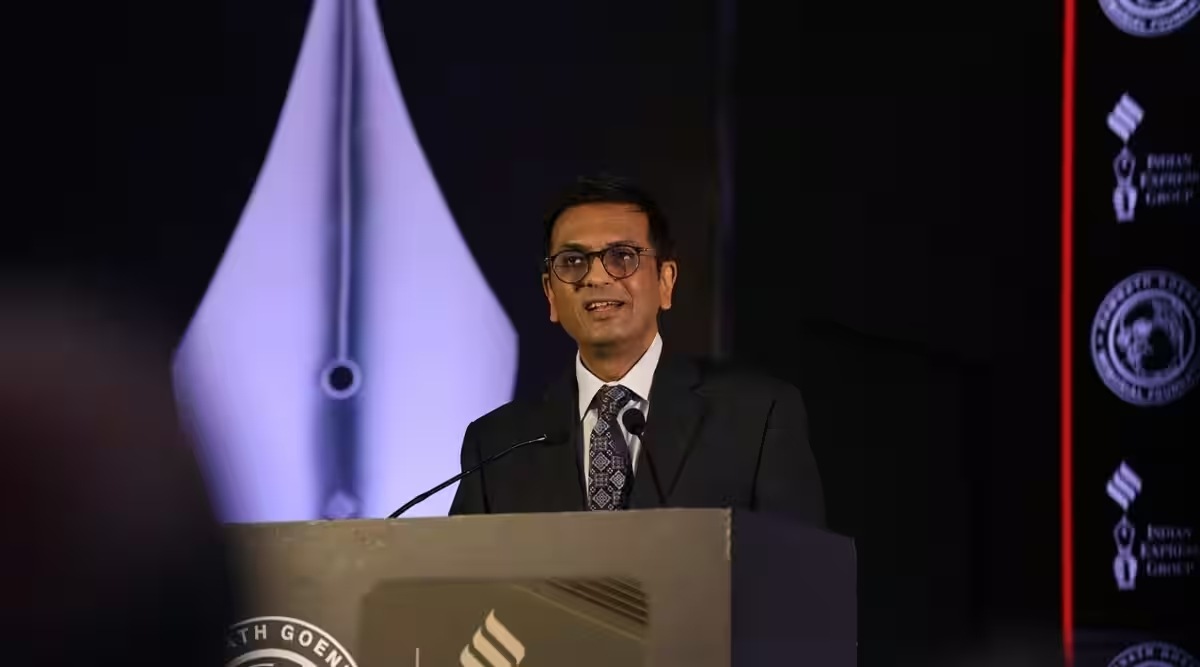Opinion CJI DY Chandrachud writes: Judges will instil confidence when their actions are uninfluenced by social, political pressure, free of bias
CJI Chandrachud writes for 'At the Steering Wheel - The Road Ahead', an Express Series: India’s model of constitutional democracy has sustained the test of time because of our entrenched constitutional values and her institutions of governance.
 Chief Justice of India D Y Chandrachud.
Chief Justice of India D Y Chandrachud. Ours is a journey of collective expectations. Independence for India was a tectonic shift from colonial rule and from a centuries-old social order based on inequality. Our shared challenges were many and so were the efforts to preserve the gains during the struggle against systems of oppression. The founding leaders charted a path to replace the colonial model of governance with institutional democracy, based on the constitutional ideals of liberty, equality, and fraternity. Our Constitution was transformative in the transfer of political power. In the aspiration to achieve a just society, the Constitution has charted out a transformative potential.
When the Constitution of India was adopted, commentators argued that India’s constitutional democracy would be short-lived in the absence of conditions necessary for the sustenance of democracy. Social equality, political literacy, and an institutional culture would, it was hoped, be the cornerstone of the new nation. The Constitution we adopted recognised the perils to democracy and national unity. It entrusted to democratic institutions the task of curing these inequities. The future of democracy would depend on this endeavour.
India’s model of constitutional democracy has sustained the test of time because of our entrenched constitutional values and her institutions of governance. Each institution contributes to democratic governance in terms of the constitutional role assigned to it. The roadmap of every institution of governance, now and in the future, must focus on strengthening the role of the institution within constitutional limits. Our effort to realise our potential and the opportunities ahead must be guided by a robust constitutional understanding of the democratic parameters governing the exercise of all authority.
 CJI Chandrachud
CJI Chandrachud
The Constitution prescribes a vital role for courts. Courts are meant to protect individuals and groups against societal injustice and arbitrariness, and ensure institutional governance within constitutional boundaries. When individuals, who face the might of the State, knock at the door of the court, they seek not just the interpretation of law or implementation of rights. They seek to utilise courts as a prominent site for democratic participation. A family seeking compensation for the death of a sanitation worker due to manual scavenging approaches the court for reasons beyond securing immediate relief. Courts are focal points for citizens to restructure the inequalities of the social order and to model a more just society. Our Supreme Court is both a constitutional court and a final court of appeal. Both those functions coalesce in fostering an orderly constitutional dialogue between citizens and their institutions.
Robust judging is all about making our process and outcomes compassionate and humane. The symbolism and the architecture of courts, such as an elevated pedestal for the seating of judges, depict an Aristotelian conception of poetic justice…such symbolism instils a sense of fear and hesitation.
The greatest challenge that the judiciary faces is to eliminate barriers to the accessibility of courts. The inaccessibility of courts, symbolic or otherwise, leads to the shrinking of democratic space. Efforts to increase access to justice must be augmented, procedurally, by loosening constraints which prevent citizens from approaching courts and, substantively, by building confidence in the work that courts undertake.
Access to justice would be a myth if courts were not approachable in every sense of the word. First, the architecture of court buildings and rigid procedural rules pose real barriers to accessing justice. The potentiality of technology must be tapped by courts in their endeavour to break the barrier. Courts have already begun the process of removing the barriers faced by persons with disabilities in accessing services of the court, such as making court files and court websites screen-readable. Courts across the country are also in the process of undertaking a physical audit of their premises to make them accessible to persons with disabilities. Court infrastructure and procedure must be remoulded by identifying sites of exclusion and catering to the needs and interests of every section of the population. It is only an inclusive judicial system that would increase the confidence of the public in the institution.
Judicial processes must open up to innovation by institutions of excellence in learning and by encouraging the interface with start-ups which are transforming the civic landscape, both in public and private life. The leadership of the court is premised on its ability to adapt to the changes in a globalised world.
Second, the opacity of the legal process and the justice system makes courts inaccessible to a large section of the population. The public must be aware of the cases which are decided by the courts and the manner in which they are decided. Recent initiatives of the Supreme Court such as live-streaming of court proceedings, translation of judgments from English to other languages with the aid of machine learning, and transcription of oral arguments, from speech to text, demystify the law and enhance the transparency of the justice delivery system. Video conferencing of court proceedings has the potential to democratise access to justice through an institution open to voices from across the nation. These initiatives aid citizens in understanding the justice system, and ease the impediments caused due to symbolism and opaqueness. Courts must reach out to citizens. Justice is more than a sovereign function: Our mission is to enhance citizen-centric services.
Third, while a transparent judicial process is the hallmark of a good justice delivery system, it is equally important to impart quality justice to gain citizens’ confidence and enhance the social legitimacy of courts. Social legitimacy can only be secured when courts establish themselves as robust and independent institutions. Judicial conduct inside and outside the courts has never been as important as it is today, in the age of social media, where every expression of a judge is dissected. The conduct of judges will instil confidence when their actions are uninfluenced by social and political pressure, and from the inherent biases that we all hold as human beings. Identification of human bias is the first step in preventing its incursion in judicial decision-making. Efforts are being made from within the institution to educate and sensitise judges across courts to unlearn their subconscious attitudes inculcated by social conditioning on gender, sexuality and caste.

Fourth, a judge must encourage dialogue and adopt an approach towards the law which is compassionate and humane. There lies, behind the nuances of legal argument in every case, a story of injustice and human suffering. Robust judging is all about making our process and outcomes compassionate and humane. The symbolism and the architecture of courts, such as an elevated pedestal for the seating of judges, depict an Aristotelian conception of poetic justice where courts are portrayed as an institution that commands law and justice in society. Such symbolism instils a sense of fear and hesitation in the minds of the common people, making courts distant and unapproachable.
Substantive access to justice can only be attained by modelling judicial decision making on the values of compassion and humanity. Wielded with a callous disregard for rights, the law has the potential to become (as it was in colonial times) a source of injustice. Wielded with empathy and common sense, the law can be humane, approachable, and empathetic. In the fast-paced and competitive world in which we live, overtaken by the large docket of cases in our courts, we often neglect the core values that make us human and overlook the purpose of the law. Judges do so at their peril.
A constitutional regime that prioritises transparency and accountability through institutional checks is facilitated by citizens’ participation. As citizens of this diverse and plural nation, it is our indispensable duty to seek answers about the functioning of democratic institutions, take part in democratic processes, and demand transparency and accountability from our courts. The functionality of all constitutional institutions is determined by their efficiency in answering the call of constitutional duty. Courts have to be efficient in dealing with the diversity of issues which come up for decision making — an arbitrary arrest, an investment dispute, a family conflict, a consumer dispute or a regulatory failure, to name a few. Our decisions in seemingly small and routine cases engender confidence in our work as judges.
Between November 2022 and August 2023, the Supreme Court disposed 38,261 cases. The Supreme Court is leading from the front by adapting to a digital environment, deploying technology to manage case-loads, setting up paperless courts, designing performance parameters for judicial appointment, machine-assisted translation of judgments into the languages in which our citizens converse and monitoring the development of judicial infrastructure.
Judicial processes must open up to innovation by institutions of excellence in learning and by encouraging the interface with start-ups which are transforming the civic landscape, both in public and private life. The leadership of the court is premised on its own ability to adapt to the changes taking place around us in a globalised world. Judicial efficiency is important in itself. But efficiency apart, our leadership of the Indian judiciary is premised on our ability to set apart time for dealing with the momentous challenges which come to the court. As an institution for constitutional dialogue, the court has a vital role in ensuring a stable order governed by the rule of law. Above all, the continued relevance of the judiciary beyond the 75th year of Independence is premised on our own ability — individually as judges and collectively as an institution — to answer our constitutional conscience.



